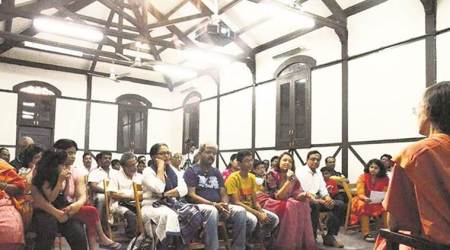 A still from Reading Architecture Practice: Mumbai
A still from Reading Architecture Practice: Mumbai
The “bastard child of a Portuguese-English wedding, the most Indian of Indian cities”. This is how Salman Rushdie described Bombay, and his reading of the country pivoted on this city, where “all rivers flowed into its human sea, where everybody talked at once”. The chaos, the calm, the industry of ideas is captured in the documentary Reading Architecture Practice: Mumbai, conceptualised by architects Rajeev Thakker, Shreyank Khemalapure and Samarth Das.
A project that grew out of conversations in 2015, between Thakker and Khemalapure, took the shape of a film through the matrix of nearly 40 architectural practises in the country. They chose to limit the number to five, and expand its width through categories of design, pedagogy, research, conservation, and multidisciplinary practise. For the film, they interviewed urbanist Prasad Shetty and architect and urbanist Rupali Gupte; architect Sameep Padora; conservation architect Vikas Dilawari; architect-activist PK Das; and from Kamla Raheja Vidyanidhi Institute for Architecture and Environmental Studies (KRVIA), Director Aneerudha Paul and Dean Research & Academic Development Rohan Shivkumar.
To each of them, the filmmakers sent a questionnaire, which included their ideas of the practise of architecture, their role and engagement in society, and why they chose Mumbai as a city to work and live in. It’s in the unfolding of these questions that the film presents its case. “We wanted to make an argument, challenge ideas, and engage with the processes of practise, and in doing that present a vision of architecture itself,” says Thakker, former Director at Studio-X Mumbai, a platform that created conversations around architecture and the urban scape.
While Shetty speaks of the “city as cumulative of all practises, where you are getting produced by the city and you are constantly contributing to the production of the city”, Padora finds interest in the interstitial city, the in-between spaces of slums and markets. “The role of an architect has been passive, restricted to providing a service. But as a discipline, we need to reclaim lost ground,”
he says.
The 37-minute film presents a textural experience of Mumbai, from its slums and high-rises, highway corridors and details of a printing press and key makers, to the sea, and the trains, capturing within its tight frames everything that one knows of the city’s imagery. What’s exquisite is the aerial footage by US-based Sensorium Works, who loaned shots of their project in Mumbai, where ribbons of grey concrete layer the city, twisting this way and that, shown against the vastness of the sea.
Paul and Shivkumar talk of “creating a new imagination” and offering a “space for rehearsal” for architects. Thakker defends the need to show academia as part of architecture in the attempt to find multiple interpretations of architecture. While KRVIA has been defining rules of engagement between public and private players, including real-estate builders in the city, Das’s activism in revitalising Mumbai’s waterfronts presents another aspect of what architecture can do.
The film, through the architects and footage, shows how the city has evolved, where gated developments have wiped away transitional spaces, where colonial buildings have been given heritage status, where civic initiatives have led to democratic action, and where schools have become participative in energising society.
Winston Churchill’s statement that we shape buildings, and then they shape us is never truer when one watches this film. It presents this synergy between the maker and the creation, and while there’s much work to be done, the film points us in the direction of conversations, which until now have rarely existed.
Reading Architecture Practice: Mumbai will be screened at KRVIA on August 16.






